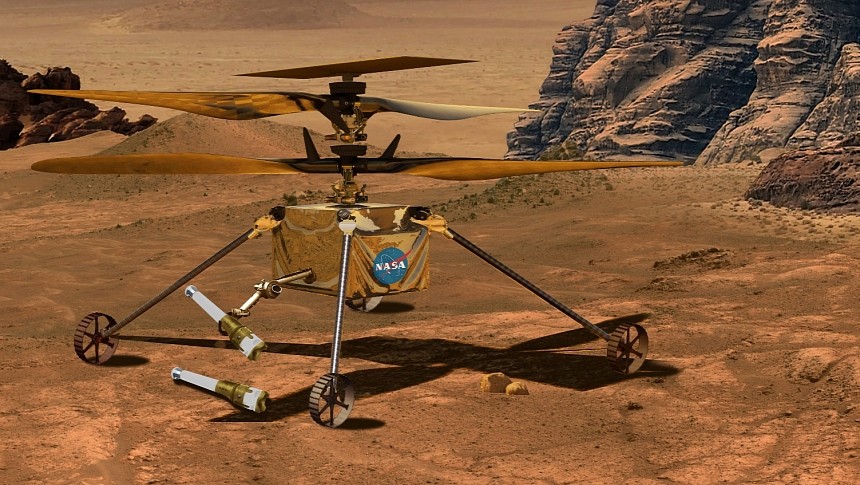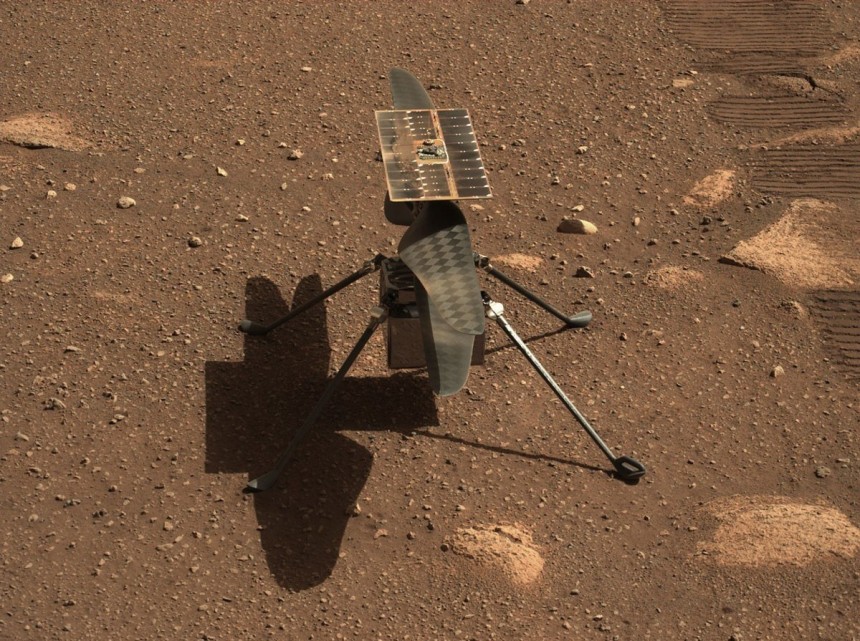Without the benefit of hindsight to guide their way, the Wright Flyer I managed to be a pretty rotten flying machine. It was indeed planet Earth's first heavier-than-air, human-crewed aircraft to fly, and therefore both the best and worst of the breed by default for a time. But for all of these reasons, it's remarkable how the first aircraft of any kind on Mars is anything but rotten. If you ask us, the Ingenuity Mars copter is the finest aircraft ever to fly. Let's take a look at why.
But to understand why the first aircraft on Earth and Mars' are so profoundly different (besides 110 years of age, of course), we need to understand just how diabolical of a flying contraption the Wright Flyer I truly was. All one needs to do to get a clue of the Wright Flyer's faults is merely look at the thing for more than five seconds to see how different it looks compared to aircraft produced even a couple of years later. Ample use of spruce and ash wood and thin canvas in the Wright Flyer's airframe may have kept it light enough for its 201 cubic-inch (3.29-liter), 12-horsepower, four-cylinder engine to push the thing into the air.
But that didn't mean it didn't come at the cost of massive instability around all three axes of flight. With elevators mounted way too close to the center of gravity and at the front of the plane instead of the rear, the only explanation behind Wilbur and Orville choosing this configuration is the above-mentioned lack of hindsight. "But what about the ailerons?" we hear you screeching from beyond the screen. Well, the Wright Flyer I didn't have any ailerons. Instead, a length of cable connected directly to the aircraft's wing tips simply warped the wing to give a rudimentary form of flight control. Oh, and the rudder was about as effective as the brakes on an old Lada.
In total, the longest of the four flights conducted at Kitty Hawk, North Carolina, on December 17th, 1903, covered less than 1,000 feet (304.8 m), was aloft for barely below one minute, and landed so shakily that by the day's end, both Wright Brothers damned the thing as unflyable and never attempted to sit in its cockpit again. To top it all off, a brisk dust storm fell over Kitty Hawk just as flight testing concluded. This storm sent the world's first human-crewed airplane tumbling end-over-end across the sand and damaged it. It's been said by historians at the Smithsonian National Air and Space Museum that Wilbur and Orville intended to burn the first Wright Flyer rather than save it as a museum piece.
This alone speaks volumes about what an infernal airplane the world's first must have been. But in every aspect where the Wright Flyer I was so horrible, NASA's Ingenuity Mars probe is the equal and exact opposite. Launched aboard a United Launch Alliance Atlas V rocket alongside the Mars 2020 program's Perseverance Rover, it'd take roughly a month lying in wait on the Martian surface before the little RC helicopter nicknamed "Ginny" spooled up its rotors and showed the world how far we've come in 120 years of aviation.
On these historic first few test flights on April 19th, 2021, Ginny tested some equipment that would have looked like witchcraft to old Wilbur and Orville. Powered by a set of six Sony SE US18650 VTC4 lithium-ion batteries similar to what you'd find in a hardware store, Ginny's 300 watts of engine power roughly rivals a mid-tier 1/12th-scale RC car or terrestrial aerial drone. But the avionics, sensors, and camera arrays that make Ginny capable of dozens of flights back to back are truly what makes Ginny a remarkable machine. In particular, Ginny's Sony IOMX 214 high-definition camera with an impressive 4208 x 3120-image resolution might be the toast of the whole darn probe.
But even in ways besides high technology, Ingenuity proves how more than a century-plus does wonders for understanding the real ins and outs of powered flight. In every way that the Wright Flyer I flew with all the grace of a seagull with a fork stuck in its beak, Ingenuity is graceful, even dignified in the air. With a light-weight four-pound (1.8-kg) airframe to lug around and carbon-fiber rotors that cut through the thin Martian atmosphere with microscopic precision, it's no wonder Ginny's spent more than an hour and a half in powered flight over 51 attempts so far. For some context, the Wright Flyer I only ever flew for roughly 98 seconds total over four agonizing flights.
By just about every conceivable metric, Ingenuity is the embodiment of every achievement made in aeronautical engineering made by pioneers the world over. It's saddening to think about how many brave men and women gave their souls and their lives to the advancement of aviation. But in the end, every ounce of blood, sweat, tears, and other bodily fluids liable to be spilled in-flight over the last century-plus has led to a species that can fly an RC helicopter around the surface of another heavenly body tens of millions of miles away. As if NASA was completely under the spell of obvious symbolism, a small piece of fabric from one of the Wright Flyer I's infernally-useless wings is sealed inside Ingenuity.
If that isn't the poetry in motion, we don't know what is. But if you're still not all that impressed, just know NASA's been working on a follow-up aircraft to Ingenuity slated to be launched on a future probe mission to the red planet. We can only imagine what that thing's capable of. But for now, if you ask us, we'd be so bold as to say the Ingenuity probe is the finest aircraft ever to take to the skies. There, we said it. Let us know in the comments if we're totally full of it. At least Ginny isn't liable to fall end over end in a wind storm. But it's only because there's probably not enough atmospheric pressure on Mars to make that happen. It still counts.
But that didn't mean it didn't come at the cost of massive instability around all three axes of flight. With elevators mounted way too close to the center of gravity and at the front of the plane instead of the rear, the only explanation behind Wilbur and Orville choosing this configuration is the above-mentioned lack of hindsight. "But what about the ailerons?" we hear you screeching from beyond the screen. Well, the Wright Flyer I didn't have any ailerons. Instead, a length of cable connected directly to the aircraft's wing tips simply warped the wing to give a rudimentary form of flight control. Oh, and the rudder was about as effective as the brakes on an old Lada.
In total, the longest of the four flights conducted at Kitty Hawk, North Carolina, on December 17th, 1903, covered less than 1,000 feet (304.8 m), was aloft for barely below one minute, and landed so shakily that by the day's end, both Wright Brothers damned the thing as unflyable and never attempted to sit in its cockpit again. To top it all off, a brisk dust storm fell over Kitty Hawk just as flight testing concluded. This storm sent the world's first human-crewed airplane tumbling end-over-end across the sand and damaged it. It's been said by historians at the Smithsonian National Air and Space Museum that Wilbur and Orville intended to burn the first Wright Flyer rather than save it as a museum piece.
This alone speaks volumes about what an infernal airplane the world's first must have been. But in every aspect where the Wright Flyer I was so horrible, NASA's Ingenuity Mars probe is the equal and exact opposite. Launched aboard a United Launch Alliance Atlas V rocket alongside the Mars 2020 program's Perseverance Rover, it'd take roughly a month lying in wait on the Martian surface before the little RC helicopter nicknamed "Ginny" spooled up its rotors and showed the world how far we've come in 120 years of aviation.
But even in ways besides high technology, Ingenuity proves how more than a century-plus does wonders for understanding the real ins and outs of powered flight. In every way that the Wright Flyer I flew with all the grace of a seagull with a fork stuck in its beak, Ingenuity is graceful, even dignified in the air. With a light-weight four-pound (1.8-kg) airframe to lug around and carbon-fiber rotors that cut through the thin Martian atmosphere with microscopic precision, it's no wonder Ginny's spent more than an hour and a half in powered flight over 51 attempts so far. For some context, the Wright Flyer I only ever flew for roughly 98 seconds total over four agonizing flights.
By just about every conceivable metric, Ingenuity is the embodiment of every achievement made in aeronautical engineering made by pioneers the world over. It's saddening to think about how many brave men and women gave their souls and their lives to the advancement of aviation. But in the end, every ounce of blood, sweat, tears, and other bodily fluids liable to be spilled in-flight over the last century-plus has led to a species that can fly an RC helicopter around the surface of another heavenly body tens of millions of miles away. As if NASA was completely under the spell of obvious symbolism, a small piece of fabric from one of the Wright Flyer I's infernally-useless wings is sealed inside Ingenuity.
If that isn't the poetry in motion, we don't know what is. But if you're still not all that impressed, just know NASA's been working on a follow-up aircraft to Ingenuity slated to be launched on a future probe mission to the red planet. We can only imagine what that thing's capable of. But for now, if you ask us, we'd be so bold as to say the Ingenuity probe is the finest aircraft ever to take to the skies. There, we said it. Let us know in the comments if we're totally full of it. At least Ginny isn't liable to fall end over end in a wind storm. But it's only because there's probably not enough atmospheric pressure on Mars to make that happen. It still counts.






















